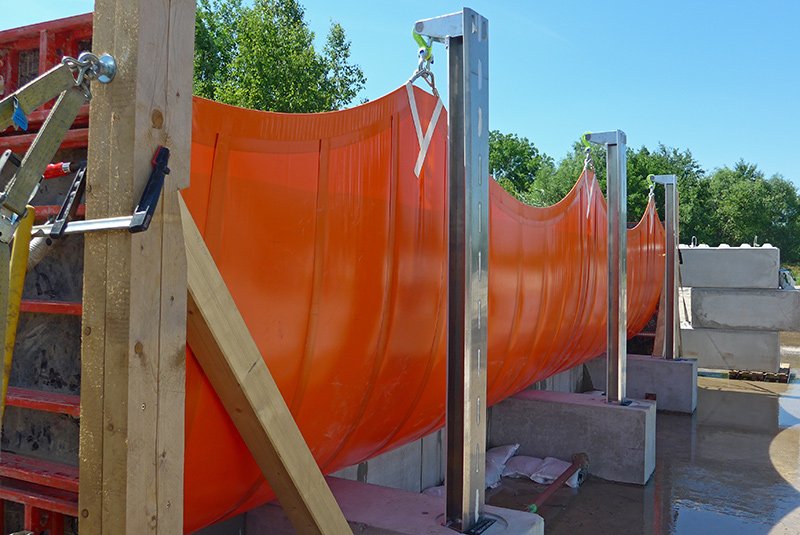Flood Control Made Easy
Scientists at the TU Chemnitz have developed a temporary system to control floodwaters – the key is a textile membrane which holds back water and diverts the active forces
-

The flood protection system with temporary retaining walls has undergone extensive testing. Photo: Rajko Berger
In a matter of hours, rivers and creeks can transform into torrential floodwaters. Rescue workers and residents of the affected cities and towns must often react quickly to the impending danger. Permanent dam installations are often not enough to contain the floodwaters. Scientists conducting research in the field of Lightweight Constructions in Civil Engineering in the Department of Lightweight Structures and Polymer Technology at the TU Chemnitz, in cooperation with several research partners, have developed a temporary system that can be installed quickly and by just a few people. The system is characterized by low initial purchase costs, uncomplicated storage and a long operating life. It can be assembled for the duration of a flood – typically just a few days per year.
The system is based on a design by Berlin-based 3dtex GmbH and is comprised of a foundation, supports and a textile membrane. It can be installed on the banks of standing or flowing bodies of water and can easily be deployed when necessary. The foundation is shaped like a trough and also serves as storage for the system. When the system is not in use, the supports cover the trough. During use, they hold the textile membrane which ultimately provides protection against the water. Researchers in Chemnitz were responsible for simulations of currents and mechanics, tests in the flow channel, developing the supports, construction of the anchor system and material testing of the membrane, supports and anchoring. The resulting system meets the requirements set forth by the Association of Engineers for Water Management, Waste Management and Land Improvement in their bulletin on mobile flood protection systems.
“What makes this system so unique is the dissipation of the forces that act on the structural components during a flood,” says Dr. Sandra Gelbrich, leader of the research group “Lightweight Constructions in Civil Engineering”, and explains: “In many of the existing temporary retaining wall systems, the water pressure results in high bending moments which particularly affect the foundation and supports. Total effort and expenditure on construction and materials is correspondingly high in systems of this kind. The advantage of this new system is based on avoiding these bending moments.” Chemnitz scientists have developed a solution in the form of a flexible membrane that does not allow much stretching, made of textile-reinforced PVC. It takes shape under water pressure and reacts only with tensile stress. The force is dissipated via the membrane’s anchoring in the ground as well as membrane edge reinforcement in the supports.
Even when debris collides with the system, the strain on the supports remains mostly unaffected. “Therefore, supports can be built extremely slim and light,” explains Gelbrich. The developers achieved this using a special geometry of the membrane and a precise arrangement of the structural components. The construction can tolerate a water level of 1.5 meters. It can withstand debris collisions up to 400 kilograms – tested with an impact angle of 90 degrees to the direction of the current and at a speed of 4 meters per second. “Thanks to the lightweight design, it is possible for just two people to construct of hundreds of meters of flood protection,” Gelbrich points out.
The project was funded by the German Federation of Industrial Research Associations from March 2013 through September 2015. The subproject carried out at the TU Chemnitz received around €175,000. The Chemnitz researchers’ partners included 3dtex GmbH, Karsten Daedler e.K. and the engineering firm Schülze & Rank.
More information is available from Dr. Sandra Gelbrich, Leader of the research group “Lightweight Constructions in Civil Engineering”, Telephone +49 371 531-32192, Email sandra.gelbrich@mb.tu-chemnitz.de
(Translation: Sarah Willson)
Mario Steinebach
30.06.2016





